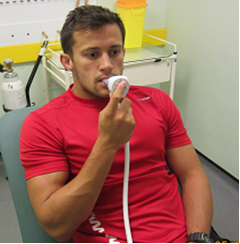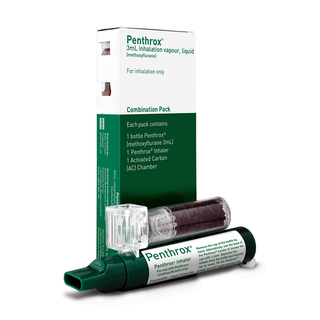Entonox
Entonox is a medical gas containing a mixture of 50% nitrous oxide and 50% oxygen.
Entonox can help patients be handled and moved with reduced pain. Within the Immediate Care in Rugby setting (after checking contra-indications) it is an ideal inhaled analgesic to assist in the safe management of fractures or dislocations.
Entonox cylinders are identified by having a blue and white cap. If the gas cylinder has a Schrader valve attachment this makes the gas only usable with a demand giving set.

Administration
Entonox is administered under clinical supervision. The gas is self-administered through a demand valve, using a mouth piece, bite-block or face mask. The demand valve opens when a small negative pressure has been generated by the patient’s inspiratory effort. The nitrous oxide is then exhaled via the expiratory port of the same valve.

The inspiratory resistance provided by the valve limits the use of the apparatus to children of approximately 5 years of age and older. To administer nirous oxide to smaller children requires an anaesthetic “T-piece circuit” in which gas flow is continuous, as this is not self-administered and requires the presence of an anaesthetist. This system is not used in pre-hospital care.
Entonox use by self-administration is safe, because if enough Entonox is inhaled to cause a reduced level of consciousness, the patient will be unable to hold the valve and will drop the apparatus, then exhale any residual gas. The mixture with 50 % oxygen, ensures the patient is adequately oxygenated.

To self-administer Entonox the patient must be fully conscious and capable of understanding what is being offered. The patients airway must be clear and the patient be able to take deep breaths. It is important to warn the patient they may become drowsy sometimes taking only four or five deep breaths will produce an analgesic effect.
Nitrous oxide is more soluble than oxygen and nitrogen will diffuse into air spaces within the body. This makes it dangerous to use in patients with a suspected pneumothorax or who have recently been scuba diving. Caution is also required with patients with bowel obstruction or head injuries, since nitrous oxide will increase the pressure effect in air spaces in these conditions too.
Contra-indications to the use of Entonox
- Head Injuries and ↓GCS: Increasing the possibility of drowsiness or loss of consciousness and possibly expanding an aerocele.
- Chest Injuries: Entonox is 34 times more soluble than nitrogen. Consequently it diffuses in to cavities more rapidly than nitrogen diffuses out . This will cause an increase in the volume of a space and an increase in the pressure effect of a gas filled cavity. This increases the risk of a pneumothorax or the conversion of a simple pneumothorax to a tension pneumothorax.
- Air Embolism: increased expansion
- Maxillofacial Injuries: increased risk of surgical emphysema and blow out fracture
- Decompression Sickness: due to increased solubility of nitrogen bubbles in the bloodstream
- Intoxication: May increase the effects of alcohol or drugs
Travelling abroad
When using Entonox abroad a variety of valve attachments may be required different to those used in in your own country.
Entonox is illegal in certain countries, if travelling abroad with a sports team it is important to check the medical regulations for that country regarding possession of Entonox.
An alternative to Entonox is Penthrox (methoxyflurane) for the emergency relief of moderate to severe pain in conscious adults with trauma-associated pain.
